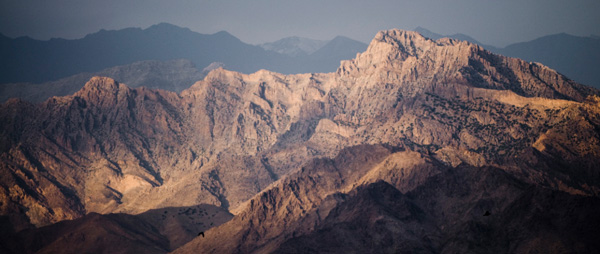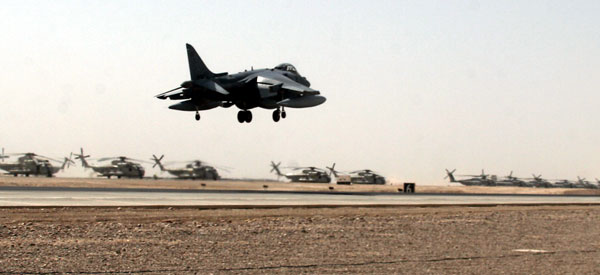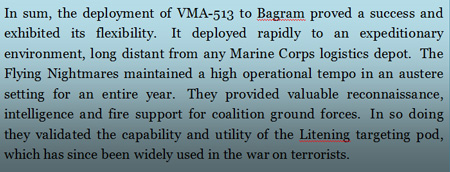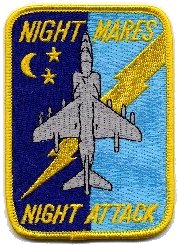By Fred H. Allison (U.S. Marine Corps History Division)

Harriers Sortie Rate Double the Norm
Making a globe-spanning flight from home field at Yuma, Arizona, the Marine aviators arrived on 15 October and began flying missions within 48 hours. The squadron deployed with only six aircraft, the limited ramp conditions at Bagram did not allow for a full squadron. Over the next 12 months the thirteen Nightmare pilots flew almost 3,800 combat hours in 1250 sorties, a rate that was near twice what a 16 plane Harrier squadron normally flew in a year.
Deployed as they were in the middle of a combat arena, all the flight time was “red ink” time, or combat time since the enemy was just outside the perimeter.[1] On an early combat mission, as he taxied for take-off in pre-dawn darkness, Colonel Dixon watched machine gun tracers spew into the sky off the end of the runway as local warlords settled differences.
Almost half of their missions were at night. When darkness settled, it was no-kidding dark, there was little “light-pollution” from large cities as would be the case in the U.S. From the ground it was eerie to watch operations around the field, one could hear Harriers taxiing, landing or taking off but not see them. From a pilot’s perspective, approaching the field to land at night they saw the town all lit up and in the “dark abyss” next to the town was the runway, “somewhere.”
The flying was extremely demanding. Radar to provide guidance into the field was limited and due to the enemy threat required “tactical” runway approaches, no slow, straight-ins. Afghanistan had little infrastructure to support aviation, such as navigation stations, radar facilities, maps, weather forecasting, air traffic control or other airfields where a pilot could land in an emergency or when bad weather shut down home base. When the war began in Iraq the U.S. Air Force AWACS (airborne warning and control system) aircraft was not available for command and control. The war in Iraq also took most of the airborne tankers. This shortened missions, lightened ordnance loads and took away the safety hedge of having more airborne fuel available if unexpected conditions arose. Pilots flew constantly evaluating the situation and weighing it against their few options.
Intelligence as the Weapon of Choice
Afghanistan previewed how the war on terror would be fought. It was a war where searching for an elusive and shadowy enemy was a central tactic and “intelligence was the primary U.S. weapon.”[2] For this fight, the Harrier proved to be of great value, mainly because Marine pilots train extensively in close air support and are genetically wired to support troops on the ground and regard it life’s greatest calling.
They also had the technology to provide superb real time intelligence information to the ground warriors: “a moving map display linked to global positioning linked to the Litening pod.” The Litening pod allowed for a magnified, precise and detailed examination of the terrain, by communicating this information to the ground troops it significantly enhanced their situational awareness. As an example, a Nightmare pilot was able to spot a man digging alongside a road at a range of 5.5 miles through the Litening pod. The pilot was able to warn the convoy of the suspicious activity.[3]
Employing ordnance was the exception. The squadron dropped 17 bombs, fired two rockets and sent almost 2,000 rounds of 25 mm down range. In most cases presence was all that was required. The Harrier is a relatively loud aircraft and its noise intimidated.
One of the special operations troops attested, the “Afghans, when they hear an airplane over head that scares the hell out of them, they won’t pull stuff when they know airplanes are overhead.” Another soldier who lived and fought out of an isolated fire base up north in the Hindu Kush mountains, where terrain is 15-20k, snow capped, beautiful and dangerous attested, “The only nights that they slept well were the nights they heard the Harriers flying overhead.”

Mission(s) Accomplished
Based close to the fight at Bagram and flying a fast jet, the Flying Nightmares responded quickly to air support requests. They were able to cover two vulnerability periods every 24 hours, each lasting at least 90 minutes or up to five hours if tankers were available. They flew in two-plane sections and employed “hunter-killer” tactics. The lead aircraft, the hunter, carried the Litening pod, which the pilot used to locate and designate targets for the “killer’s” ordnance. Precise delivery of ordnance when used, was critical as in a counter-insurgency collateral damage had to be minimized if they were to win hearts and minds.
The Litening pod helped locate the target and because of its infrared marker, (“finger of death”) which could be seen by pilots and the forward air controllers using night vision devices, certainty of target identification could thus be had. One U.S. Army special operations officer based at Jalabad stated that, “They did everything we asked them to do and more. They would take the time to really look for the bad guys. They would also tell us about bad guys beyond the range where we were looking. They talked us through things, we really felt that the Harriers knew what they were doing. I feel that [they] appreciate what we’re up against on the ground.” General Dan K. McNeill, USA, commander of all coalition forces in Afghanistan at the time received “constant” favorable reports on VMA-513’s performance. Two VMA-513 pilots, Major Mike Franzak and received distinguished flying crosses for providing game-changing air support for ground troops in dire situations.
In sum, the deployment of VMA-513 to Bagram proved a success and exhibited its flexibility. It deployed rapidly to an expeditionary environment, long distant from any Marine Corps logistics depot. The Flying Nightmares maintained a high operational tempo in an austere setting for an entire year. They provided valuable reconnaissance, intelligence and fire support for coalition ground forces. In so doing they validated the capability and utility of the Litening targeting pod, which has since been widely used in the war on terrorists.
It also breathed new life into the controversial Harrier itself; indeed the success of VMA-513’s Bagram deployment took the wind out of the sails of a Los Angeles Times story that attacked the Harrier’s safety record which appeared in late 2003. The Marine Corps general at the helm of Marine aviation regarded the Nightmare’s Bagram deployment as singularly important for “saving the AV-8B.” The Flying Nightmares 2002-2003 Bagram deployment pioneered the way for subsequent deployments of Harriers to Afghanistan by the Marine Corps and the Royal Air Force.
The Marine Corps likes to advertise its expeditionary nature, to be fast, austere, innovative and lethal in any clime and place. The Flying Nightmares modeled these attributes in their Bagram deployment.
[1] Called red ink time because combat flights are logged in a pilot’s log book in red ink.
[2] Don Chipman, “Air Power and the Battle for Mazar-e Sharif,” Air Power History, Spring 2006, p. 44.
[3] Dixon intvw.
———-
***Posted January 10th, 2010




